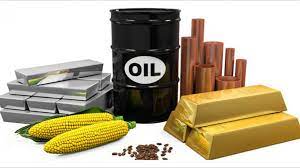Why did commodities plummet?

There was a collective collapse in commodities. What happened? Just as the market was worried that China's overall cut in reserve reserve ratio might aggravate the rise in commodity prices, the commodity market ushered in a sharp drop on Monday, and crude oil prices were the first to bear the brunt. After the Brent active contract price hit our target price of US$75/barrel at the beginning of the month ("Meeting Another Wave of Commodity Rise"), it fell below the important mark of US$70 this Monday. In the unpredictable market environment, how to understand the pulsation of the commodity market?
We have reviewed the price trends of crude oil and copper in the past 50 years from the perspectives of supply and demand (black font), policy (red font) and events (blue font). Figures 1 to 4. Historically, what was the main reason for the oil price to fall below 70 dollars? What's the trend of oil prices afterwards? We select the market quotations of 2006, 2010, 2014 and 2018 as reference:
2006: The Fed continued to tighten its austerity and the economy slowed down and demand fell, while OPEC insisted on not cutting production. Crude oil fell below $70 twice; finally, the Iranian nuclear issue eased in August, and the Gulf of Mexico hurricane hit less than expected, causing oil prices to fall continuously Break the 70 and 60 dollar mark.
2010: OPEC kept production unchanged, but the outbreak of the European debt crisis caused the global economy to bottom out for the second time and demand weakened. Oil prices briefly fell below $70 in May, but then the global economy returned to recovery and oil prices continued to rise.
2014: The U.S. and non-U.S. economic policies diverged, the Fed withdrew from QE, and the global economy slowed down; the U.S. increased production sharply, OPEC unexpectedly announced that it would not reduce production, excess supply triggered a price war, oil prices fell below 70 U.S. dollars, and a bear market started.
2018: Under the risk of the Federal Reserve's continued interest rate hikes and trade frictions, the global economy has slowed significantly, oil demand growth has been weak, but supply has continued to increase, and the US sanctions on Iran have fallen short of expectations, and oil prices have plummeted since October. At the beginning of 2019, OPEC cut production and the Fed stopped raising interest rates, and oil prices only returned to above $70 in the second quarter.
Looking ahead, we believe that there is still adjustment pressure in the short term, but the commodity bull market may not be over yet. On Monday, oil prices led to a sharp decline in commodities, but from the above three perspectives, the sustainability of the continued sharp decline in oil prices is doubtful:
1. At the supply and demand level, although the market is worried that OPEC+ will increase production and demand will slow down due to repeated epidemics, the increase in production has not exceeded market expectations and OPEC+ has clearly stated that it will consider suspending production or even returning to production reduction in the event of a slowdown in demand. In addition, the temperature this summer is high , This will lead to a seasonally high demand for crude oil, and the possibility of a major hurricane in the Gulf of Mexico affecting crude oil production will increase;
2. At the policy level, although the Fed has begun to consider gradually withdrawing from easing, the economic and policy differentiation in China, the United States, and the United States and Europe will slow down this process;
3. At the event level, although the epidemic has repeatedly relapsed, the intensity of the repetition and the impact on the economy are constantly weakening.
However, Monday’s sharp drop also sounded a “wake-up call” for us. With marginal changes in policies and the disturbance of the epidemic, the adjustment of commodity prices has not yet ended in the short term, and price fluctuations will increase in the second half of the year.



